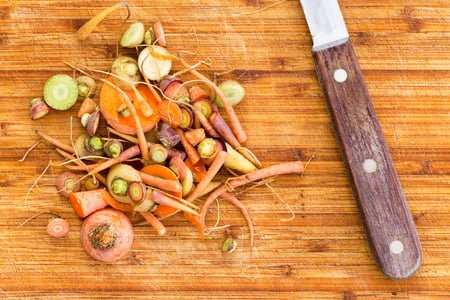Imagine if every third customer to your restaurant ordered a meal, looked at the plate, then immediately threw it away.
That's pretty much what's happening. A whopping 25 to 40 percent of food that is grown, processed and transported in the United States will never be eaten. Around 80 billion pounds of food ended up in landfills last year, the Food Waste Reduction Alliance estimates, and 43 percent of that waste comes from restaurants and institutions.

Foodservice industry groups are working to reduce barriers to food recycling and donation efforts. But there's also a lot that individual restaurant companies can do. Here are six ideas for restaurant food waste management.
1. Examine food waste with a creative eye.
In March 2015, Chef Dan Barber turned his Greenwich Village restaurant, Blue Hill, into a pop-up called WastED. Barber served delicious dishes made from ingredients that would normally be discarded: bruised bok choy, vegetable peelings, fish skin, beet pulp and pasta remnants. The result was a culinary sensation.
Of course, if you're not a renowned chef who runs a $100/plate restaurant, it could be hard to convince customers to nibble on fish bones. Nor do you have to. "At Blue Hill, we constantly audit our kitchen waste, asking ourselves what is not being used and what we might make with it," Barber tells Food & Wine. "Look at your carrot and turnip tops and think pesto. Or soup. Working with this stuff stretches you as a cook and makes you more mindful and creative."
Chefs have countless tricks for turning food waste into favorite dishes. Cheese rinds can be simmered in pasta sauce or stock for a soup base. Vegetable peels can become ravioli filling. Even tough leek tops can be blended into pesto or dehydrated to become flavoring powder.
2. Fit food waste reduction into other culinary trends.
Food waste management is hot — it ranked among the top 20 food trends in the National Restaurant Association's 2016 list. And if you need inspiration, look at how waste reduction intersects with other trends on the list:
- #18: House-made pickles. What better use for cucumbers, carrots and other vegetables that are approaching middle age? These sriracha fridge pickles from Bon Appetit are made with the stems of Swiss chard.
- #6: Environmental sustainability. Consumers are learning that sustainability is about more than organic apples and free-range chicken — especially if both apples and chicken end up being thrown away. A restaurant's approach to waste reduction is a big part of sustainability.
- #4: Hyper-local sourcing. Picking produce as needed is a smart way to reduce food waste — and as fresh veggies come in the door, compost from the kitchen can go out. Here are tips on starting a restaurant garden from expert Geri Miller.
Download "A Strategy Guide for Foodservice Sustainability" today and get more tips!
3. Track what's being thrown away.
You may already know that your kitchen discards a lot of lettuce — but is it 15 pounds per week or 150? The EPA has free tools for conducting food-waste assessments, such as a cost calculator and a paper log for recording food losses, quantities and reasons.
If that's a little too analog for you, LeanPath offers online trackers to record the same info and also run reports to help reveal costs and provide more accurate forecasting. Case studies describe university dining services that discovered enormous quantities of bakery items and salad bar produce were going bad, allowing them to adjust their offerings and save money.
4. Consider composting a last resort.
The process of composting is strangely satisfying, as mushy tomatoes and moldy lemons magically become rich soil. But compost should be the last option for recovering wasted food, the EPA says in its Food Recovery Hierarchy. Instead, focus first on cutting waste at the source; then feed people (via donation programs) and animals; seek industrial re-use options; and finally compost.
5. Blend, blend, blend.
A Hamilton Beach Commercial culinary blender is a kitchen's secret weapon for salvaging less-than-perfect produce or leftover cooked meat. Overripe fruits become smoothies or coulis. Leafy herbs, like basil or cilantro, can be pureed with lime and garlic to make a zippy green sauce. And everything can become soup.
A note of caution: while soups can save huge amounts of food from being wasted, they can also contribute to the problem. LeanPath recommends making small batches throughout the day instead of a giant vat of soup that may go uneaten -- so make sure you understand your restaurant's requirements.
6. Make food waste reduction sexy.
"Produce waste reduction" = boring.
"Loving ugly vegetables" = marketing gold.
Around 20 percent of freshly grown produce is immediately thrown away just because of its appearance — forked carrots, crooked cucumbers, gnarled potatoes. Several companies have found an enthusiastic audience for their efforts to embrace these "ugly" fruits and vegetables. Imperfect Produce is a San Francisco-area company that sorts and delivers interestingly shaped produce to homes and offices at a discount. Misfit Juicery, a Washington, D.C.-based company, makes cold-pressed juice from cosmetically challenged fruits and veggies.
The takeaway here is that restaurateurs shouldn't hide their waste-reduction efforts behind closed doors. Instead, trumpet what you're doing and have fun with it. Customers want to feel virtuous about their eating, and reducing waste is part of that.
How are you planning to tackle food waste as a part of your foodservice operation? Let us know in the Comments below. And if you have a fun or interesting story idea, please submit it here. The best stories will be developed and published on our blog to be distributed to the international HBC Community, with your name attached. A little publicity can always help to grow your business and awareness.



